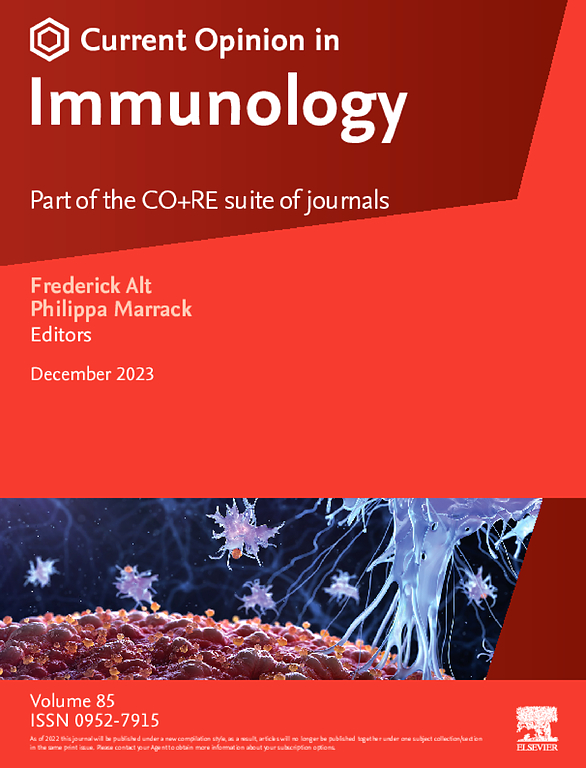Skin manifestations of SARS-CoV-2 infection and its vaccination
IF 5.8
2区 医学
Q1 IMMUNOLOGY
引用次数: 0
Abstract
SARS-CoV-2 infection and vaccination are associated with a broad range of skin manifestations, including chilblains, urticaria, morbilliform and papulovesicular rashes, purpuric-necrotic lesions, and autoimmune flares. These patterns reflect differences in the timing and nature of type I interferon (IFN-I) responses. Rapid TLR7-mediated IFN-I production by plasmacytoid dendritic cells (pDCs) in the upper airways restricts viral replication; hyperresponsive pDCs protect from severe infection but may cause chilblain-like lesions through exaggerated local inflammation. When early IFN-I responses are weak, viral spread to the lungs triggers endothelial cell death, mitochondrial DNA release, and cyclic GMP-AMP synthase (cGAS)-stimulator of interferon genes (STING) activation, producing a late IFN-I surge that amplifies inflammation, mirrored by morbilliform, vesicular, or necrotic skin lesions. mRNA and viral vector vaccines can similarly activate nucleic acid sensors, inducing IFN-I–driven rashes, and promote spike-specific T cells that cross-react with skin antigens. Recognizing these cutaneous signs offers insight into the balance between protective and pathogenic immunity in COVID-19.
SARS-CoV-2感染的皮肤表现及其疫苗接种
SARS-CoV-2感染和疫苗接种与广泛的皮肤表现有关,包括冻疮、荨麻疹、麻疹和丘疹样皮疹、紫癜性坏死病变和自身免疫性闪光。这些模式反映了I型干扰素(IFN-I)反应的时间和性质的差异。上呼吸道浆细胞样树突状细胞(pDCs)快速tlr7介导的IFN-I的产生限制了病毒的复制高反应性pdc可防止严重感染,但可能通过局部过度炎症引起冻疮样病变。当早期IFN-I反应较弱时,病毒传播到肺部触发内皮细胞死亡、线粒体DNA释放和环GMP-AMP合成酶(cGAS)-干扰素基因刺激因子(STING)激活,产生晚期IFN-I激增,放大炎症,反映为麻疹状、水泡状或坏死的皮肤病变。mRNA和病毒载体疫苗同样可以激活核酸传感器,诱导ifn - i驱动的皮疹,并促进与皮肤抗原交叉反应的刺突特异性T细胞。识别这些皮肤体征有助于了解COVID-19中保护性免疫和致病性免疫之间的平衡。
本文章由计算机程序翻译,如有差异,请以英文原文为准。
求助全文
约1分钟内获得全文
求助全文
来源期刊
CiteScore
13.30
自引率
1.40%
发文量
94
审稿时长
67 days
期刊介绍:
Current Opinion in Immunology aims to stimulate scientifically grounded, interdisciplinary, multi-scale debate and exchange of ideas. It contains polished, concise and timely reviews and opinions, with particular emphasis on those articles published in the past two years. In addition to describing recent trends, the authors are encouraged to give their subjective opinion of the topics discussed.
In Current Opinion in Immunology we help the reader by providing in a systematic manner: 1. The views of experts on current advances in their field in a clear and readable form. 2. Evaluations of the most interesting papers, annotated by experts, from the great wealth of original publications.
Current Opinion in Immunology will serve as an invaluable source of information for researchers, lecturers, teachers, professionals, policy makers and students.
Current Opinion in Immunology builds on Elsevier''s reputation for excellence in scientific publishing and long-standing commitment to communicating reproducible biomedical research targeted at improving human health. It is a companion to the new Gold Open Access journal Current Research in Immunology and is part of the Current Opinion and Research(CO+RE) suite of journals. All CO+RE journals leverage the Current Opinion legacy-of editorial excellence, high-impact, and global reach-to ensure they are a widely read resource that is integral to scientists'' workflow.

 求助内容:
求助内容: 应助结果提醒方式:
应助结果提醒方式:


